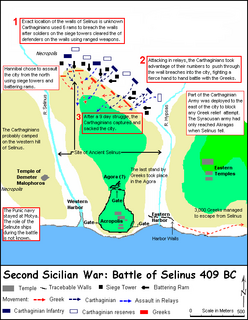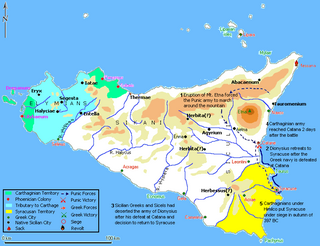 W
WThe siege of Akragas took place in 406 BC in Sicily; the Carthaginian enterprise ultimately lasted a total of eight months. The Carthaginian army under Hannibal Mago besieged the Dorian Greek city of Akragas in retaliation for the Greek raids on Punic colonies in Sicily. The city managed to repel Carthaginian attacks until a relief army from Syracuse defeated part of the besieging Carthaginian army and lifted the siege of the city.
 W
WThe Battle of Catana took place in the summer of 397 BC. The Greek fleet under Leptines, the brother of Dionysius I of Syracuse, engaged the Carthaginian fleet under Mago near the city of Catana in Sicily. While the Greek army under Dionysius was present near the city of Catana during the battle, the Carthaginian army under Himilco was away in the interior of Sicily, making a detour around the erupting Mount Etna. The Carthaginian fleet crushed the Greek fleet in the battle, leading to the Carthaginian siege of Syracuse later in 397 BC.
 W
WThe Battle of the Crimissus was fought in 339 BC between a large Carthaginian army commanded by Asdrubal and Hamilcar and an army from Syracuse led by Timoleon. Timoleon attacked the Carthaginian army by surprise near the Crimissus river in western Sicily and won a great victory. When he defeated another much smaller force of Carthaginians shortly afterwards, Carthage sued for peace. The peace allowed the Greek cities on Sicily to recover and began a period of stability. However, another war between Syracuse and Carthage erupted after Timoleon's death, not long after Agathocles seized power in 317 BC.
 W
WThe Battle of Gela took place in the summer of 405 BC in Sicily. The Carthaginian army under Himilco, which had spent the winter and spring in the captured city of Akragas, marched to confront the Greeks at Gela. The Syracuse government had deposed Daphnaeus, the unsuccessful general of the Greek army at Akragas, with Dionysius, another officer who had been a follower of Hermocrates. Dionysius schemed and gained full dictatorial powers. When the Carthaginians advanced on Gela and put the town under siege, Dionysius marched from Syracuse to confront the threat. He planned to use a complex three-pronged attack plan against the Carthaginians, which failed due to lack of proper coordination. Dionysius chose to evacuate Gela, as the defeat caused discontent in Syracuse and he did not wish to lose his power. Himilco sacked the abandoned city after the Greeks had fled to Camarina.
 W
WNear the site of the first battle and great Carthaginian defeat of 480 BC, the Second Battle of Himera was fought near the city of Himera in Sicily in 409 between the Carthaginian forces under Hannibal Mago and the Ionian Greeks of Himera aided by an army and a fleet from Syracuse. Hannibal, acting under the instructions of the Carthaginian senate, had previously sacked and destroyed the city of Selinus after the Battle of Selinus in 409. Hannibal then destroyed Himera which was never rebuilt.
 W
WThe Battle of Himera, supposedly fought on the same day as the Battle of Salamis, or at the same time as the Battle of Thermopylae, saw the Greek forces of Gelon, King of Syracuse, and Theron, tyrant of Agrigentum, defeat the Carthaginian force of Hamilcar the Magonid, ending a Carthaginian bid to restore the deposed tyrant of Himera. The alleged coincidence of this battle with the naval battle of Salamis and the resultant derailing of a Punic-Persian conspiracy aimed at destroying the Greek civilization is rejected by modern scholars. Scholars also agree that the battle led to the crippling of Carthage's power in Sicily for many decades. It was one of the most important battles of the Sicilian Wars.
 W
WThe Battle of the Himera River was fought in 311 BC between Carthage and Syracuse near the mouth of the Himera river. Hamilcar, grandson of Hanno the Great, led the Carthaginians, while the Syracusans were led by Agathocles. Agathocles initially surprised the Carthaginians with an attack on their camp, but the Greeks lost the battle when they were attacked by unexpected Carthaginian reinforcements. The Greek army took many casualties as it retreated. Agathocles managed to gather the remains of his army and retreat to Syracuse, but lost control of Sicily.
 W
WThe Battle of Selinus, which took place early in 409 BC, is the opening battle of the so-called Second Sicilian War. The ten-day-long siege and battle was fought in Sicily between the Carthaginian forces under Hannibal Mago and the Dorian Greeks of Selinus. The city of Selinus had defeated the Elymian city of Segesta in 415, an event that led to the Athenian invasion of Sicily in 415 and ended in the defeat of Athenian forces in 413. When Selinus again worsted Segesta in 411, Carthage, responding to the appeal of Segesta, had besieged and sacked Selinus after the Carthaginian offer of negotiations had been refused by the Greeks. This was the first step towards Hannibal's campaign to avenge the Carthaginian defeat at the first battle of Himera in 480. The city of Selinus was later rebuilt, but never regained her former status.
 W
WThe siege of Syracuse in 397 BC was the first of four unsuccessful sieges Carthaginian forces would undertake against Syracuse from 397 to 278 BC. In retaliation for the siege of Motya by Dionysius of Syracuse, Himilco of the Magonid family of Carthage led a substantial force to Sicily. After retaking Motya and founding Lilybaeum, Himilco sacked Messana, then laid siege to Syracuse in the autumn of 397 BC after the Greek navy was crushed at Catana.
 W
WThe Battle of White Tunis was fought between Carthage and the tyrant Agathocles of Syracuse in 310 BC. It was the first large battle of the Agathocles' military expedition to Libya. Even though heavily outnumbered by the Carthaginian army, the soldiers of Agathocles were far more experienced in warfare than the Carthaginian citizen soldiers. Another important factor was the terrain, which prevented the Carthaginians from using their numbers to outflank Agathocles. The Carthaginian suffered a serious defeat, which caused some of the Carthaginian allies to change their allegiance to Agathocles.